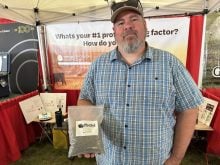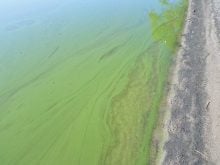Across the Prairies, new cost of production figures and calculators for 2017 are appearing on provincial websites to help producers make sound production, management and marketing decisions.
On the marketing side things look a little rosier than they did this time last year. “When you look forward to September 2017, it doesn’t look as bad as a year ago when we were looking forward at September 2016,” said Roy Arnott, farm business specialist with Manitoba Agriculture at a meeting of the Border Agricultural Stewardship Association (BASA) meeting in Cartwright, Manitoba in December. “Prices are looking better. We’ve still got big world stocks and a lot of competition out there, so I don’t see a lot of upside per say, but I also don’t see as much downside as we did potentially a year ago.”
Read Also

Cancer agency reclassifies another herbicide ‘probably carcinogenic’
The WHO’s cancer research agency has now put atrazine, a herbicide well known to corn growers, in the same potential-hazard category where the agency put glyphosate.
A year ago canola was sitting at $10.25 per bushels and was $10.75/bu. in December 2016, and while wheat prices remained soft because of large world supplies, soybean are looking strong. “When you start to look out in the $11.50/bu. range for September 2017 delivery in soybean that’s not bad at all.”
COP relatively stable
Arnott went on to discuss some of the cost of production (COP) figures recently released by Manitoba Agriculture for 2017. Production costs for most major Manitoba crops varied from $150 to $200/ac., and when all fixed and operating costs are factored in the COP is anywhere from $300 to $400/ac., with corn the most expensive at $450/ac.
- Read more: The farmland cost factor
“When we take a historical look at wheat COP we’ve definitely been increasing since 1990, but the last few years have been relatively flat after we came off high fertilizer prices after the stock market meltdown,” said Arnott. “The slight dip we’re looking at this year is mostly due to fertilizer being off just a little bit. Canola is the same thing. COP has been relatively stable the last couple of years, but most of the cost increase in canola is due to seed, which has increased over the past number of years.”
Buy fertilizer in the fall
Fertilizer is a major input cost, and buying it in the fall might save a considerable amount of money. Arnott’s long-term figures show that generally fertilizer prices are lower in fall than in spring. Urea prices average 13 per cent lower in fall than in spring and phosphate is 16 per cent lower. A Manitoba farm buying 160 tonnes of urea and 50 tonnes of phosphate could save almost $18,000 a year on average by buying in the fall rather than the spring.
The problem is that often, producers are simply too busy in the fall to even think about buying fertilizer. “I believe producers have to buy fertilizer more strategically,” said Arnott. “This past fall, urea was $400/tonne but I think there was very little bought and very little applied mostly because everyone was trying to finish up harvest,” said Arnott. “There were deals to be had and few could take advantage, which was unfortunate. Heading into spring, we’re probably going to be in the $500/tonne range for urea.”
Phosphate follows the same trend — this fall was retailing around $600/tonne and Arnott predicts that price will probably be around $625 in the spring. “If producers can buy fertilizer in the fall or work a deal with their retailer then, the better off they’re going to be.”
The best returns
Arnott predicts chemical input costs will rise in the region of around two to three per cent for 2017, and seed costs overall will continue to trend upwards, especially for canola, which may make some other crops, like soybean, increasingly attractive. “We have pegged canola seed prices for the COP at $60 an acre, but if you start packaging up things like clubroot and shatter resistance, you’re rocketing to $70/ac. for canola seed,” said Arnott. “Some areas are having challenges getting good yields, and the question is how much money producers can afford to put into canola and still come out the other side.”
Arnott ran through some scenarios based on local yield averages for the local area (Risk Area 5) of 42 bu./ac. canola, 55 bu./ac. wheat and 36 bu./ac. soybean. Projected fall prices for the calculations were $10.75/bu. for canola, $6.25/bu. for wheat and $11.50/bu for soybean.
Arnott’s 2017 profitability analysis for Risk Area 5 shows a $200/ac. margin over operating costs for canola, but only $80/ac. when all fixed costs are factored in. “Wheat has a lower margin over operating expense, but soybean is holding a good margin based on a 36 bu./ac. yield at $11.50/bu. Soybean is cranking out quite a bit of money with a little less cost and getting good returns.”
That’s causing Arnott to speculate that soybean acres are going to continue to grow in southern Manitoba as more producers move away from canola or grow it every three years in rotation as opposed to every two years.
Corn is another option that some producers are considering, adds Arnott, and his figures show some decent net margins can still be achieved in the $35 to $37/ac. range but there are equipment considerations — like the need to purchase planters and headers — that may put a bit of a damper on corn’s push further west.
How much insurance do you need?
Another significant and important COP that many farmers overlook or simply don’t think about is crop insurance. For the first time, this year’s Manitoba COP guide includes an AgriInsurance Analysis calculator, which Arnott hopes will help producers think more strategically about their insurance needs.
“At 80 per cent insurance coverage the operating costs are all covered for all the major Manitoba crops,” said Arnott. “But it doesn’t cover any of the fixed and labour costs.”
Again, using Risk Area 5 figures, a canola crop has $56 of costs not covered, wheat has $9 of costs and soybeans have $100 of costs not covered by insurance at the 80 per cent level. “If you took 80 per cent coverage and you had a wreck, you have essentially got 70 per cent of your total costs covered in general,” said Arnott. “When producers look at crop insurance I think they have to be realistic as to what level they need. Young producers starting out have to insure everything at the highest rate because they don’t have anything behind them. But after years of farming, when producer have fewer liabilities, maybe they only need to insure at a level that covers their operating costs, because we need to be insuring liabilities not revenues.”
















